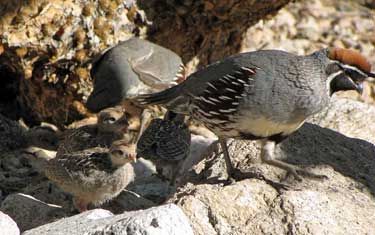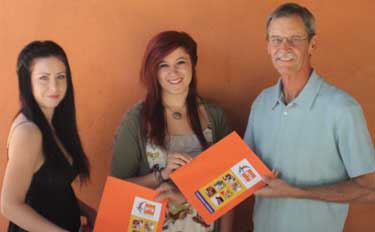JUNE 24, 2011
Residents invited to learn about proposed changes for Crossroads East
SCOTTSDALE – The Arizona State Land Department is requesting to amend the land use and stipulations for the Crossroads East Planned Community District, east of Scottsdale Road and north/south of the Loop 101 freeway. The change would accommodate additional retail uses including auto sales, and adjust the number of allowed residential units - thus providing consistency with areas adjacent to this property. You can learn more and comment about this request at an open house from 4 to 6 p.m. Monday, June 27, at the Scottsdale Airport Terminal, 15000 N. Airport Drive. Get more information at this website or by calling Mark Edelman, Arizona State Land Department, at (602) 542-6331 or Kroy Ekblaw, city of Scottsdale, at (480) 312-7064.
BY BRENDA OLIVE | JUNE 22, 2011

We Brake for Baby Quail!
May we protect this never-ending source of enjoyment
Have you noticed the young additions to the bird population in your yard lately? In my estimation, the most popular newcomers are the young in Gambel’s quail families often seen scampering across the road. I find myself holding my breath hoping that each quail makes it safely to the other side. If you see a family crossing the road, please hit the brakes – the young can’t get out of the way as fast as the adults. Just a second or two can make a difference between life and death!
It is fun to watch them come to our watering hole led by protective parents. When they leave, one parent leads the way while the other waits to see that there are no stragglers. It is important now to see that fresh, clean water is available.
 The number of Gambel’s quail that will hatch this time of year depends almost entirely on rainfall. But the rain must come at the right time. If adequate winter rain falls, the desert blooms with wildflowers, seeds and forbs (Wikipedia: Forbs are herbaceous flowering plants that are not graminoids (grasses, sedges and rushes). Quail relish the green growth, such as bursage which contains vitamin A and triggers the bird’s sexual response.
The number of Gambel’s quail that will hatch this time of year depends almost entirely on rainfall. But the rain must come at the right time. If adequate winter rain falls, the desert blooms with wildflowers, seeds and forbs (Wikipedia: Forbs are herbaceous flowering plants that are not graminoids (grasses, sedges and rushes). Quail relish the green growth, such as bursage which contains vitamin A and triggers the bird’s sexual response.
The green growth means quail pairing, nest construction and the laying of big clutches of eggs. It also means that there will be plenty of seeds when the young begin to forage.
Gambel’s quail can commence breeding activities as early as February, and later in higher elevations. Nesting begins shortly afterwards and peaks by mid-June. Clawing and using sharp beaks, quail hollow out a bowl-shaped nest in the ground to hold 9 to 15 speckled, buff-colored eggs. Their incubation period is only 21 days, and baby quail hatch with the help of the mother quail as she pecks away at their shell. The father quail keeps the hatchlings together until all eggs are hatched.
They all leave the nest immediately, fully clothed and ready to go exploring and foraging for food and water.
A high protein diet is required and is satisfied by insects that develop in the growing spring vegetation. When the young reach maturity, various seeds from this same growth provide the larger proportion of the high energy food needed until the next winter crop of annual growth. However, did you know that 60 to 70 percent of the young hatched each summer disappear by winter through natural mortality?
The key to an abundant quail population (as for most wildlife) is an adequate food supply throughout the year. Man’s disturbance of the desert has contributed to reducing and altering the amount of supportive natural habitat required. Wildlife in need of food does not reason or heed property boundaries. The greener oases of landscaped and watered yards are likely to attract wildlife to off-limits munching of domestic plants, cacti and trees.
Chicken scratch or wild bird seed can be made available in the same place at approximately the same time daily, preferably near protective vegetative cover, and not abruptly discontinued. I find myself bird watching for hours as they feed. I listen to the adult quail conversing with their young in their own special way.
Water needs to be kept fresh and free of contaminating algae and debris. The ideal water container is both shallow (such as a jar lid) and large in circumference. If the container is too deep, quail chicks and other small animals can drown. Don’t be surprised if a toad hops into the water for a moisturizing renewal!
Our Gambel’s quail are a never-ending source of enjoyment. May we always protect their habitats so that generations to come will continue to have this natural source of pleasure in the desert.
JUNE 22, 2011
Three college arts scholarships awarded by Sonoran Arts League
 College bound art students Lexie Janke (left) and Virginia Prostor are shown receiving their achievement scholarships from Sonoran Arts League scholarship chairman Mike Markham. The League awards scholarships each year to encourage young adults to follow pursue their passion for art, along with their college education.
College bound art students Lexie Janke (left) and Virginia Prostor are shown receiving their achievement scholarships from Sonoran Arts League scholarship chairman Mike Markham. The League awards scholarships each year to encourage young adults to follow pursue their passion for art, along with their college education.
CAVE CREEK/CAREFREE/N. SCOTTSDALE – Three college-bound art students from Cactus Shadows High School were awarded achievement scholarships by the Sonoran Arts League, a non-profit organization dedicated to advancing art, artists and art education.
Virginia Prostor, 18, received the Sonoran Arts League top scholarship award of $2,000, along with the $1,000 Stuart Otis Scholarship.
Prostor, who started her own photography business in 2009, recently graduated from Cactus Shadows High School. She will study at Paradise Valley Community College where she has already completed 35 credit hours towards her Associate’s Degree. Prostor then intends to study at ASU’s Herberger Design Institute.
Also awarded scholarships were Lexie Janke, 17, Cave Creek and Nicole Haan. Janke, a watercolorist, will attend Northern Arizona University. Her work entitled Koi Fish was recently featured on the cover of an area arts magazine. Haan was recognized for her watercolors and drawings.
The Sonoran Arts League is widely known for their Hidden in the Hills Artist Studio Tour that takes place annually over the last two weekends in November and features nearly 150 artists throughout 45 working studios in the NE Valley. The League is also host of Festival of Fine Art in Cave Creek and the Empty Bowls Project in Carefree.
“The League’s mission is to advance art, artists and art education, and the scholarships support the overall goals of the League,” said scholarship chairman Mike Markham.
“The schools have eliminated so many of the art programs, yet art is something we need to live a full life. The Sonoran Arts League scholarships ensure that inspired, talented young adults will continue to follow their passion and achieve their educational goals,” said Markham.
The non-profit Sonoran Arts League was formed in 1975 as the Cave Creek Craft Council, and advances art, artists and art education. The organization’s 450+ members actively participate in community outreach programs including youth mentoring and art education. The Sonoran Arts League also partners with the Foothills Foodbank in the Empty Bowls Project and produces the Festival of Fine Art and the Small Works Show and Sale.
To reach the Sonoran Arts League, call 480-575-6624, visit 6051 E. Hidden Valley Drive, Cave Creek or write PO Box 1689, Cave Creek, AZ 85327. Or, visit the League on the web at www.sonoranartsleague.org, on Facebook facebook.com/sonoranartsleague or facebook.com/hiddeninthehills and on Twitter at twitter.com/sonoranartsleague.




